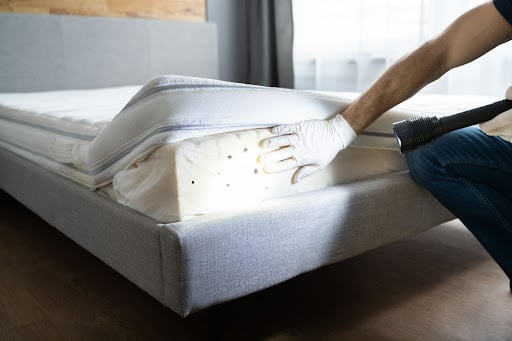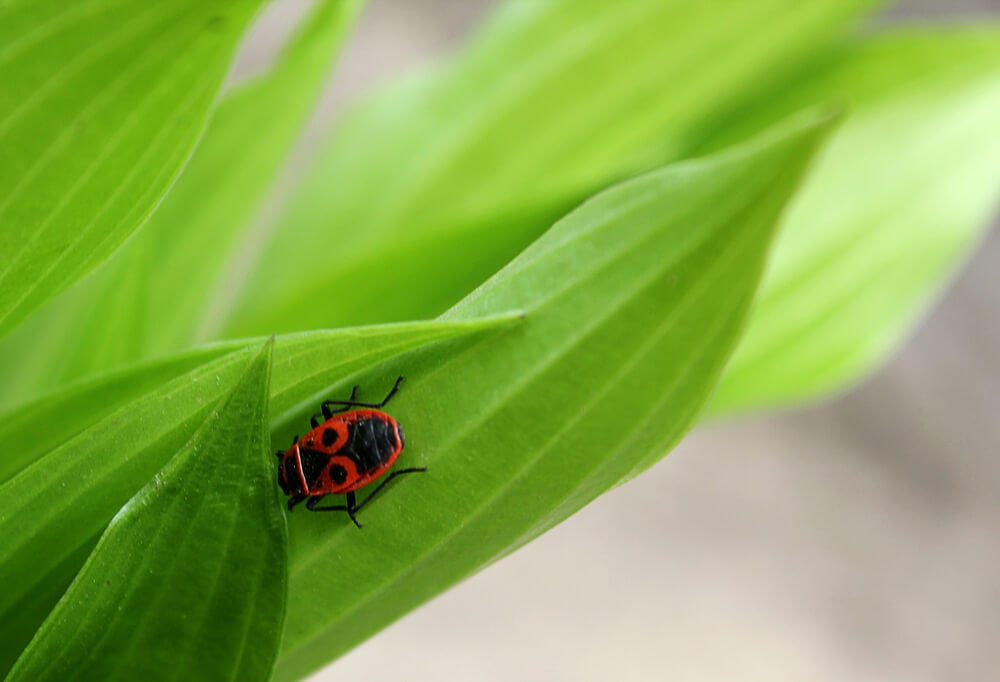It can be tough not to feel paranoid about bed bugs. They’re smaller than the size of an apple seed, only come out when you sleep and are a pain to get rid of! If you’re waking up with small, itchy bug bites, think you may have spotted one, or notice stains on your mattress, don’t panic yet.
Plunkett’s is here to break down three major signs of bed bugs (staining, remnants, and bites). So, if you ever find yourself losing sleep and scratching your skin because of phantom bugs, pause and look for these signs of bed bugs and bed bug indicators first:
What Do Bed Bugs Look Like
Since they’re so tiny and their bites can be mistaken for other insects like chiggers, mosquitoes, and fleas, it’s important to know exactly what bed bugs look like. The first myth about bed bugs is that they’re impossible to spot with the naked eye. In reality, adult bed bugs are 4-5mm long, while only the nymphs are difficult to see. Bed bugs are wingless with flat, brown bodies that become reddish in color after feeding.

They are sometimes known as “bed beetles” and will typically hide in the crevices of your mattress or boxspring, in cracks in your walls, and under your bed. They are slow-moving and come out to feed at night on a warm, nearby host. Now that you know what bed bugs look like, here are tell-tale signs of their presence.
Signs You Have Bed Bugs
Bed Bug Staining
The first-bed bug indicator is a variety of stains on your bedding, curtains, or other bedroom furniture. Stains on your bed are worth a closer look as they’re a common indicator of bed bugs.
There are three main types: blood stains, yellow stains or “rust” stains, and black spots. You may also want to read up on the best stain remover for bed bugs if you end up finding them.
1. Bed Bug Blood Stains

It’s important to note that finding blood stains on your bed sheets does not automatically mean you have bed bugs. Blood stains can happen for several reasons. You could have itched a scab while you were sleeping or reopened a cut while tossing and turning.
The blood stains you’re looking for are primarily small, dark red, and either roundish or smeared. Bed bug blood stains occur during feeding and are notably found near the foot of the bed or on your pillowcase. The space between your pillow and pillow case makes a perfect daytime hiding spot, so it’s possible to crush them when you lie down and cause a small red stain on your pillow as well.
2. Yellow Bed Bug Rust Stains

The second most common are yellow bed bug stains that appear rust-colored. The cause of these stains is bed bug excrement or crushed eggs. Excrement is a rusty red, brown, or black color, and it tends to bleed into bed sheets, almost like a felt-tip pen or marker would. Excrement stains are quite small and look dot-shaped or splotchy. Over time, these stains can diffuse to cover a larger area and fade to a lighter brown color.
3. Black Spots

These types of stains also come from blood or bed bug excrement but can appear darker if the blood or fecal matter is less fresh. Since bed bugs feed on blood, they often excrete this digested blood, and it can show up as a smattering of small dark spots on your sheets as time passes. If you see a cluster of small black spots on your bedding and know you don’t have a mold problem, bed bugs could be the culprit.
Bed Bug Remnants
The second most common sign of bed bugs is remnants from the pest itself in the form of molted skin, eggs or a prominent musty odor.
1. Shed Skin Cells
Believe it or not, bed bugs actually have to shed their skin five times before reaching full maturity. This means they’ll be leaving behind traces of skin from molting if they’re present in your residence. These skins are slightly smaller than the bug itself, translucent, pale yellow, and slightly crusty. Bed bugs require a full blood meal before molting, but it takes bed bugs 24 hours to digest these meals and they need to remain stationary while they do so. Look for shed skin husks in places where bed bugs might hide, like under the bed or behind the headboard. Keep in mind that over time, these skins may break into small, dry flakes.

2. Eggs
Bed bug eggs are quite sticky so the pest can lay them on nearly any surface, including walls or ceilings. They’re usually laid in pods or clusters in hidden locations, such as the lower sides of beds. Crushed or hatched eggs may leave behind faint, small yellow stains on fabric, as we mentioned before.

3. Musty Odor
Bed bugs smell when crushed or threatened by releasing an “alarm pheromone” from their scent glands. This odor smells quite similar to a stink bug’s odor, and it may smell musty, woody, rotten, or sweet. Many people compare it to the smell of concentrated coriander.
Whatever you think it smells like, chances are you won’t like it, and it will be noticeable enough to detect. Worst of all, this smell tends to linger, especially if it stains fabric. Bed bug infestations also continually produce this scent. If you can’t tell whether or not you have bed bugs, try thoroughly washing and replacing your bed sheets. If the smell reappears right away, chances are bed bugs are the culprit!
Remember: bed bugs don’t just hang around beds, either. If you smell a musty scent near old furniture, fabrics, or sheets, in your bedroom specifically, check for bed bugs right away.
Bed Bug Bites

The last key sign of a bed bug infestation is the presence of bites. Unfortunately, it’s easy to get bed bug bites confused with other common insect bites like fleas, chiggers and mosquitos. Here’s how to tell bed bug bites from other bites:
Bites from bed bugs can appear on any area of skin that is exposed when sleeping (unlike flea bites that will be concentrated around the ankles). They will appear as small red bumps ranging in features such as a clear center, dark center, swollen exterior and zig-zag pattern.
They’ll be very itchy and can worsen a day or two after the initial bite. Since they vary in appearance and mimic other insect bites mentioned above, avoiding bed bug bites can only be done once you’ve used the above indicators like staining, odors, or sightings to confirm bed bugs in your home.
In Need of Bed Bug Control?
If you’ve identified bed bugs in your home or have noticed any of the tell-tale signs we mentioned above, it’s time for bed bug pest control. While you can attempt to get rid of bed bugs on your own, it’s difficult as they breed so rapidly and the nymphs are so difficult to see.
Rest easy at night by calling Plunkett’s pest control. We can identify the problem using our K-9 bed bug detection team and rid your space of bed bugs efficiently and effectively. Schedule a service today!









